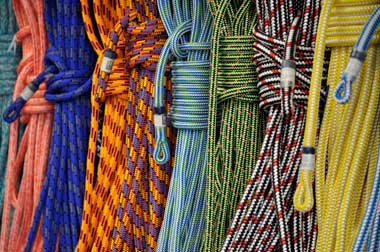Advanced tree climbers can stop reading now - this blog post is not for you! And… when Treetools refers to 'dummies' we don't literally mean 'dummies' - we are talking to readers new to tree climbing (in a kind-hearted way).
Listed below is a non-intimidating series of questions first time tree climbing line buyers should ask themselves before investing.
Newbies to tree climbing often find the selection of their first climbing line a daunting task.
Most have little idea of what to look for in a rope and getting technical advice about rope construction, elongation, heat resistance, average break strengths, working loads and knot-ability does not initially help them in the decision making process - confusion is the more likely outcome.
Tree climbing purists will say 'if you don't know what climbing line to buy you should not be climbing a tree' but to apply this sentiment, in the everyday world, is simply unrealistic - there are plenty of experienced climbers out there who have no clue as to what climbing line they are on, referring instead to color when they come to re-purchase.
Not ideal we know but that is the fact of the matter.
So for those of you who need some practical, but not too technical, help in selecting the right climbing line - read on.
When is a rope not a rope? When it's a line!
In the nautical world, with its long history of rope handling, the term 'rope' refers to the manufactured material - that is, rope on a roll, coiled or boxed. Once rope is cut to length, knotted, spliced, stitched, or simply assigned a function in the climbing or rigging system the result is referred to as a 'line' - climbing line, access line, rigging line etc.
Now that's out of the way ask yourself the following questions:
1) How will the climbing line be secured in the canopy?
Over a branch (natural crotch), ringed rope saver, pulley saver? Most newbies are anchoring over a branch so a climbing line with high abrasion resistance is preferable over a less durable line (even if it is the right color). For example, 16-strand Samson Arbormaster with its polyurethane coating would make a good choice in this application.
2) What friction hitch or climbing configuration do I intend to use?
By way of example, mechanical devices severely restrict the choice of climbing line due to the tight tolerances within which they operate.
A friction hitch offers far greater latitude in terms of rope diameter and functionality. A climber using a prussic loop is unlikely to need a high-tech climbing line! But one planning to use mechanical ascenders might.
3) How high in the tree am I comfortable climbing?
Most newbies order too long a climbing line in the first instance (thinking rope length is the measure of a man). If you are only confident climbing up to 10 meters then a 45 meter climbing line will end up being more nuisance than value.
The best idea is to take the height you are comfortable climbing and multiply that by two - you can add about 5 more meters if you are still unsure but that will be plenty of length in a DbRT climbing system.
4) How does the rope feel in my hand?
There is no point buying an 11mm climbing line if it does not feel comfortable in the grip of your hand. Be mindful, you will be handing this line day-in, day-out and it's not much fun body thrusting (hauling your sorry arse) up a piece of string!
5) How 'hard' or 'soft' does it feel when my weight is applied?
All lines offer different degrees of elongation relative to body weight but start quoting these figures to most climbers and their eyes begin to glaze over. Instead of figures and percentages get on the rope and 'feel' your weight in the line - you will have a far greater understanding of the concept than you'll get in any amount of textbook analysis.
6) Color!
You thought we'd miss this one out because it was irrelevant; but, not so! A boldly colored climbing line is far more useful than a highly camouflaged (but sexy) alternative! The fiber pigmentation in the rope also effects the behavior and 'feel' of the climbing line so do not discount color in the selection list.
7) Strength?
Newbies fret about the strength of the rope and its ability to hold their body weight but all tree climbing lines sold through Treetools are manufactured to an appropriate standard - in most cases that is EN1891-A (or B) - well capable of supporting the climber… plus some.
Please note; buying rope (or tree climbing line to be more precise) from a dodgy supplier is not covered in this post!
Now, that was not so difficult, was it?
Selecting a new climbing line does not need to be intimidating - after reading this post you might not know everything there is to know about climbing lines but you can learn more about the technical details as you develop your tree climbing skills further - just like the pro's once did.

